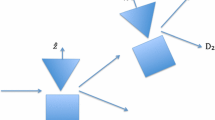Abstract
Bell's theorem is expounded as an analysis in Bayesian probabilistic inference. Assume that the result of a spin measurement on a spin-1/2 particle is governed by a variable internal to the particle (local, “hidden”), and examine pairs of particles having zero combined angular momentum so that their internal variables are correlated: knowing something about the internal variable of one tells us something about that of the other. By measuring the spin of one particle, we infer something about its internal variable; through the correlation, about the internal variable of the second particle, which may be arbitrarily distant and is by hypothesis unchanged by this measurement (locality); and make (probabilistic) prediction of spin observations on the second particle. Each link in this chain has a counterpart in the Bayesian analysis of the situation. Irrespective of the details of the internal variable description, such prediction is violated by measurements on many particle pairs, so that locality—effectively the only physics invoked—fails. The time ordering of the two measurements is not Lorentz-invariant, implying acausality. Quantum mechanics is irrelevant to this reasoning, although its correct predictions of the statistics of the results imply it has a nonlocal—acausal interpretation; one such, the “transactional” interpretation, is presented to demonstrable advantage, and some misconceptions about quantum theory are pursued. The “unobservability” loophole in photonic Bell experiments is proven to be closed. It is shown that this mechanism cannot be used for signalling; signalling would become possible only if the hidden variables, which we insist must underlie the statistical character of the observations (the alternative is to give up), are uncovered in deviations from quantum predictions. Their reticence is understood as a consequence of their nonlocality: it is not easy to isolate and measure something nonlocal. Once the hidden variables are found, all the problems of quantum field theory and of quantum gravity might melt away.
Similar content being viewed by others
References
J. S. Bell,Physics 1, 195–200 (1964). Reprinted as Chapter 2 of J. S. Bell,Speakable and Unspeakable in Quantum Mechanics (Cambridge University Press, Cambridge, 1987).
A. Einstein, B. Podolsky, and N. Rosen,Phys. Rev. 47, 777–780 (1935).
D. Bohm,Quantum Theory (Prentice-Hall, Englewood Cliffs, New Jersey, 1951), Section 22.16.
E. T. Jaynes, inFoundations of Probability Theory, Statistical Inference, and Statistical Theories of Science, W. L. Harper and C. A. Hooker, eds. (Reidel, Dordrecht, 1976), pp. 175–257. Largely reprinted as Chapter 9 of Ref. 5.
E. T. Jaynes,Papers on Probability, Statistics and Statistical Physics, R. D. Rosenkrantz, ed. (Synthese Library158) (Reidel, Dordrecht, 1983).
A. J. M. Garrett, “Macroirreversibility and microreversibility reconciled: The second law,” to be published inMaximum Entropy in Action, B. Buck and V. A. Macaulay, eds. (Oxford University Press, Oxford).
R. T. Cox,Am. J. Phys. 14, 1–13 (1946).
M. Tribus,Rational Descriptions, Decisions and Designs (Pergamon, New York, 1969).
E. T. Jaynes, inMaximum Entropy and Bayesian Methods in Inverse Problems, C. R. Smith and W. T. Grandy, Jr., eds. (Reidel, Dordrecht, 1985), pp. 21–58.
A. Garg and N. D. Mermin,Found. Phys. 14, 1–39 (1984).
A. J. M. Garrett, inMaximum Entropy and Bayesian Methods, J. Skilling, ed. (Kluwer, Dordrecht, 1989), pp. 93–105.
A. J. M. Garrett,Found. Phys. 20, 381–402 (1990).
J. F. Clauser and A. Shimony,Rep. Prog. Phys. 41, 1881–1927 (1978).
A. Aspect, J. Dalibard, and G. Roger,Phys. Rev. Lett. 49, 1804–1807 (1982).
S. L. Braunstein and C. M. Caves,Phys. Rev. Lett. 61, 662–665 (1988).
A. Fine,Phys. Rev. Lett. 48, 291–295 (1982).
N. D. Mermin,Phys. Today 38(4), 38–47 (1985).
N. D. Mermin, inNew Techniques and Ideas in Quantum Measurement Theory, D. M. Greenberger, ed.,Ann. N. Y. Acad. Sci. 480, 422–427 (1986).
D. M. Greenberger, M. A. Horne, and A. Zeilinger, inBell's Theorem, Quantum Theory, and Conceptions of the Universe, M. Kafatos, ed. (Kluwer, Dordrecht, 1989), pp. 69–72.
N. D. Mermin,Am. J. Phys. 58, 731–734 (1990).
P. M. Pearle,Phys. Rev. D 2, 1418–1425 (1970).
M. Lamehi-Rachti and W. Mittig,Phys. Rev. D 14, 2543–2555 (1976).
D. Hestenes,Am. J. Phys. 47, 399–415 (1979).
D. Hestenes, inClifford Algebras and Their Applications in Mathematical Physics, J. S. R. Chisholm and A. K. Common, eds. (Reidel, Dordrecht, 1986), pp. 321–346.
F. Herbut and M. Vujicic,J. Phys. A 20, 5555–5563 (1987).
P. J. Bussey,Phys. Lett. A 90, 9–12 (1982).
E. T. Jaynes, inBayesian Analysis and Decision Techniques: Essays in Honour of Bruno de Finetti (Studies in Bayesian Econometrics 6), P. K. Goel and A. Zellner, eds. (Elsevier, Amsterdam, 1986), pp. 31–42.
E. T. Jaynes,IEEE Trans. Syst. Sci. Cybern. SSC-4, 227–241 (1968); reprinted as Chapter 7 in Ref. 5.
J. von Neumann,Mathematical Foundations of Quantum Mechanics (Princeton University Press, Princeton, New Jersey, 1955), pp. 305–324. (English translation of German original, 1932.)
D. Bohm,Phys. Rev. 85, 166–179 and 180–193 (1952).
J. S. Bell,Rev. Mod. Phys. 38, 447–452 (1966). Reprinted as Chapter 1 of Ref. 1.
J. S. Bell,Found. Phys. 12, 989–999 (1982). Reprinted as Chapter 17 of Ref. 1.
F. J. Belinfante,A Survey of Hidden-Variables Theories (Pergamon, Oxford, 1973).
D. Hestenes,Found. Phys. 15, 63–87 (1985).
D. Hestenes, The Zitterbewegung interpretation of quantum mechanics,Found. Phys. 20, 1213–1232 (1990).
J. G. Cramer,Rev. Mod. Phys. 58, 647–687 (1986).
K. V. Roberts,Proc. R. Soc. London A 360, 135–160 (1978).
J. A. Wheeler and R. P. Feynman,Rev. Mod. Phys. 17, 157–181 (1945).
J. A. Wheeler and R. P. Feynman,Rev. Mod. Phys. 21, 425–433 (1949).
Author information
Authors and Affiliations
Rights and permissions
About this article
Cite this article
Garrett, A.J.M. Bell's theorem and Bayes' theorem. Found Phys 20, 1475–1512 (1990). https://doi.org/10.1007/BF01883519
Received:
Issue Date:
DOI: https://doi.org/10.1007/BF01883519




